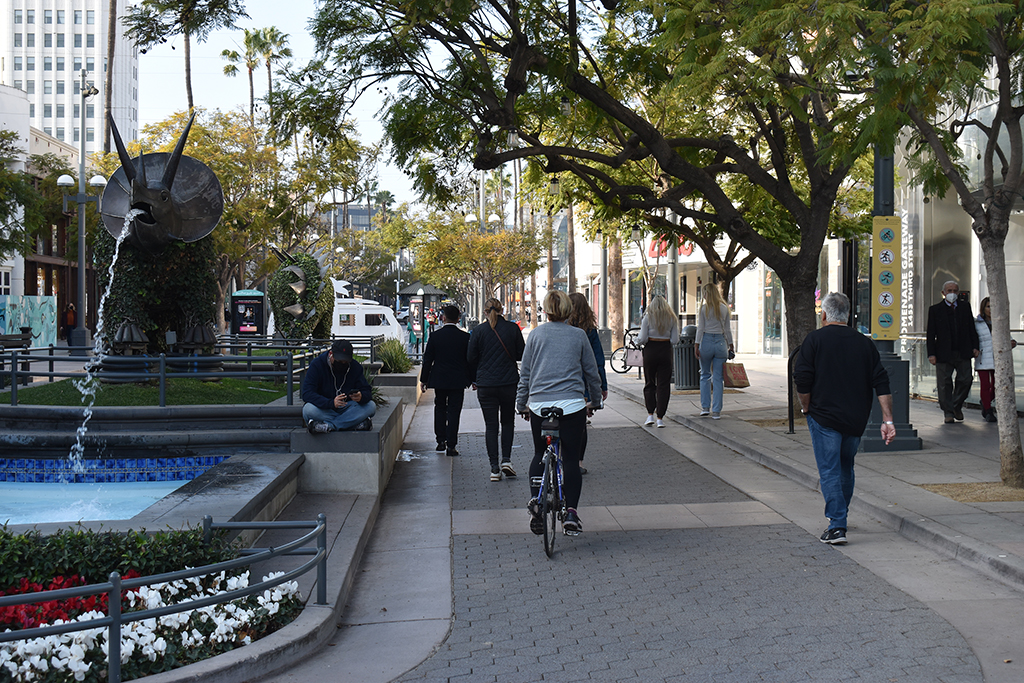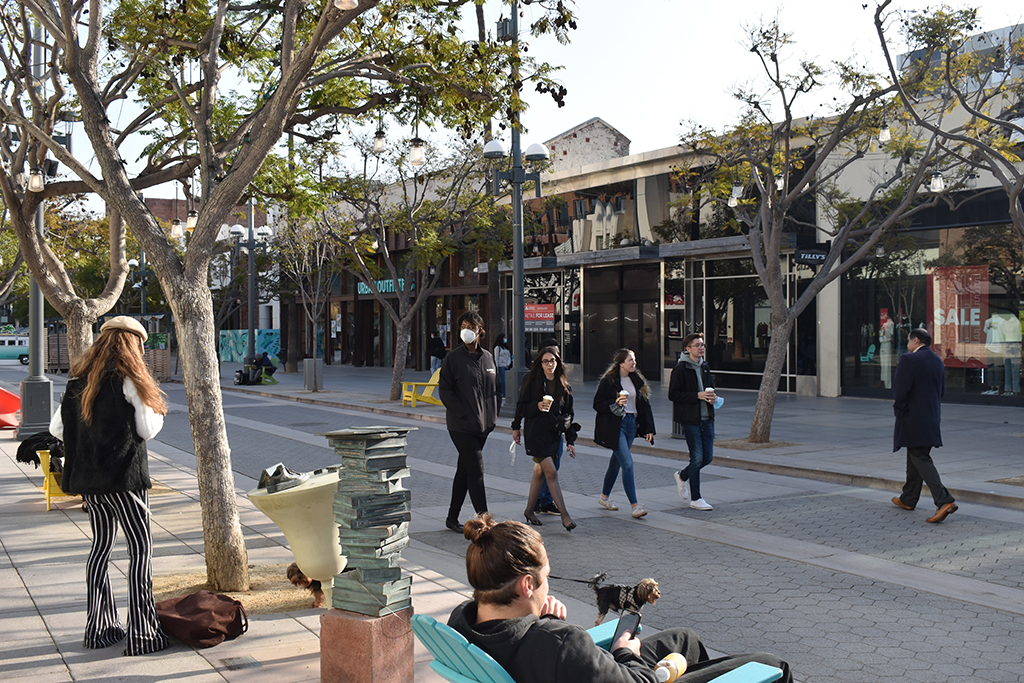Dec. 31 marked the end of another challenging year for Santa Monica’s retail and restaurant industries, but with visitorship up and the Super Bowl on the horizon, early indicators provide reasons for optimism going into 2022.
Santa Monica Travel & Tourism (SMTT) reported local hotel occupancy in December was an average of 65.4 percent — a more than three-fold increase over December 2020’s rate, but still below the 72 percent occupancy seen in December 2019. The average daily hotel room rate for December was $346, up from 2020’s average which was in the $200s, SMTT reported.
Sensors located along the Third Street Promenade that help the local business district measure foot traffic on the pedestrian thoroughfare showed promising numbers in December, despite it being one of the rainiest holiday seasons on record. The automated system includes an algorithm to avoid one pedestrian being counted multiple times, according to Downtown Santa Monica’s (DTSM) Mackenzie Carter, but even so, the numbers are used more as a general indicator than a rock-solid metric measuring economic success.
“It’s really giving us a general idea of how many people are walking on the street at any given time,” Carter, DTSM Director of Marketing & Communication, recently told the Daily Press. “Now that we’ve had it for a few years, that allows us to compare year-over-year.”
Recent numbers showed that about 288,000 pedestrians visited the Promenade from the week of Dec. 27-Jan. 2 — a 189 percent increase over 2020’s dismal numbers for the same stretch. The New Years holiday weekend of Dec. 31-Jan. 2 saw 88,768 pedestrians counted, which was over 7,000 more than had visited that same weekend in December 2019, before COVID-19 struck.
In fact, December’s daily average of 59,697 pedestrians was a fraction higher than numbers counted in December 2019 (when 56,883 pedestrians were counted each day, on average); according to information provided by DTSM, it was the first month that pedestrian count averages have been higher than a pre-covid month.
“We did have a lot of rain, but despite that, we had really great pedestrian numbers,” Carter said.
How those numbers translate to business revenue is a bit tricker to quantify.
While an increase in pedestrian traffic usually correlates with a similar increase in business traffic, COVID-19’s lifestyle changes made that correlation less reliable.
“For example, during COVID, a lot of people were just out taking walks, and so we didn’t really see that correlation — but in non-pandemic times, we definitely saw a correlation between the number of people on the street and the sales tax dollars that covers the city,” Carter explained.
Carter and Santa Monica Economic Development Manager Jennifer Taylor both said that, while pedestrian count measures were a helpful metric, sales tax data is needed to measure the true health of the local economy. Those numbers were not expected for several weeks.
Taylor anticipated a “slow but steady road” that would see the city budget “back on track” in the next three to five years; current trends indicate the City has remained on track, even despite virus and weather related obstacles.
Both Taylor and Carter pointed to the City’s interim zoning ordinance, passed in 2020, that has helped bars and restaurants stay open even amid three major COVID-19 surges seen in the past 12 months.
“It’s allowed, in some cases, many of our restaurants to double their capacity in terms of the number of customers they can potentially serve, and continue to serve those who wish to be outside as much as possible,” Taylor said, adding that it was not just restaurants but salons, studios and fitness centers that were able to move outdoors, as well.
“It’s amazing to see the variety of businesses that use the Santa Monica Outdoors Program,” Taylor continued. “So, I think that’s been really key. The fact, too, our city leadership, the Council, has supported expansion of fee waivers to Santa Monica Outdoors, has really been very important. Basically, it means that their temporary use permit has no permit fee.”
Programs like that have provided a lifeline to businesses along Main Street, according to Main Street Santa Monica Executive Director Hunter Hall.
In addition to the expansion of outdoor services, Hall cited California’s Alcohol Beverage Control (ABV) offering flexibility for outdoor alcohol service as a major factor helping with restaurant revenue.
“When you get an ABC license, or liquor license, you have to submit a floor plan and you’re only allowed to serve alcohol in that area. So, you know, pre-COVID, a normal restaurant couldn’t just decide to take over their parking lot and start serving alcohol,” Hall described. “So, the ABC changing that rule temporarily did allow them that, and they’ve been expanding, which is great.”
Another adaptation, Hall said, was the expansion of catering offerings, with restaurants pivoting to large-scale take-out operations.
Those changes, combined with government loan programs and the eviction moratorium, helped keep Santa Monica’s service economy from collapsing over the past two years, Hall said — but the situation was far from stable.
“That doesn’t really tell the whole story,” Hall said. “And the whole story really is, that despite the fact a lot of these restaurants are still open, technically, they’re on life support. You know, they’re probably one bill away from closing.”
Carter said that, while downtown had seen its share of closures in the past two years, vacancies on the Promenade, which peaked at about 45 percent, were down to 25 percent with recent rental agreements, including a new food hall that opened in December and a new tattoo parlor — the Promenade’s first — expected to open soon.
But with restaurant owners continuing to take on debt, Hall predicted more local restaurants on Main Street may be declaring bankruptcy into 2022, even as the economy was picking back up.
Added to those stresses was the tight labor market, which both Hall and Carter noted as an obstacle for local businesses.
“Right now, one of the biggest issues everywhere in the United States is, you know, people calling out sick or the ‘Great Resignation.’ People are just operating on really lean staff,” Carter said. “I think that could really affect business operations going forward, if we don’t see people coming back to work.”
Hall said he empathized with workers who resigned during the pandemic, remarking that “let’s be honest, the public is kind of the worst sometimes,” especially given the current political divide happening in the country.
Hall said the labor market upheaval was happening in every industry, not just food and retail, but referred to it as a “Great Reshuffling,” rather than a “Great Resignation.” He added that Santa Monica’s restaurants have stayed competitive in the labor market by offering benefits like paid sick leave to employees that restaurants in other cities do not provide.
While the ongoing virus surge due to the omicron variant of COVID-19 has had visitors and locals alike second-guessing outings, the winter surge correlated with Santa Monica’s slowest retail season, Hall said. Taylor and Carter both added that outdoor dining meant there were options for people who otherwise would not feel safe dining due to the highly transmissible new variant.
While the first quarter of the calendar year may be a slow period for the local economy, this year’s Q1 has a bright spot for business owners: the Super Bowl, which was set to take place in Inglewood in February.
Though SMTT was not able to provide booking stats or a projected hotel occupancy rate for Super Bowl weekend, Carter and Taylor predicted the game and associated events would draw visitors to help boost the local economy.
During the week of the big game, Santa Monica is set to play host to a number of events, including a carnival-type “tailgate” on the Promenade, a charity fashion show and the official NBC pregame show broadcast, set to take place on the Pier. And even those visitors not attending a ticketed local event will be more likely to spend money.
“Not only will people be attending events, but they’ll also be staying in Santa Monica while they’re here for the Super Bowl,” Carter said. “And so, we’ll just have that foot traffic and then people wanting to go out and grab a bite to eat or hang out in the park or go down to the beach. I think we’re just going to see just general foot traffic for those reasons.”
SMTT provided a guide to watch the Super Bowl in town, available at santamonica.com/super-bowl.
emily@smdp.com











